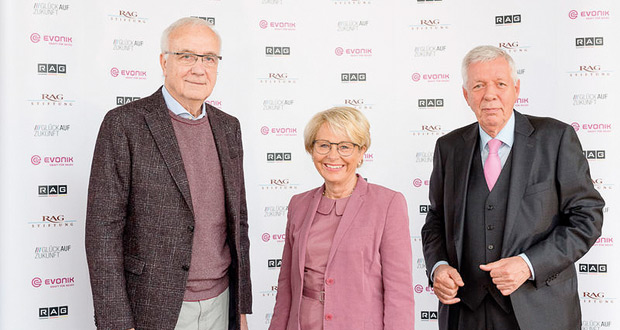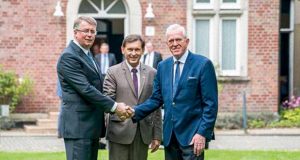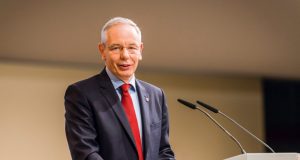Roughly two years ago, the Essen/Germany based RAG-Stiftung foundation, RAG AG and Evonik Industries AG collaborated with the IG BCE union, Hanover/Germany, to launch the “Glückauf Zukunft!” project, aiming to wind down the German coal mining industry by the end of 2018. The programme acknowledges the industry’s historical achievements while simultaneously setting a course for the era to come. The interim results are encouraging, as the first set of projects has proved very popular. “Glückauf Zukunft!” is growing with impressive momentum.
“What started as an joint initiative by the RAG-Stiftung, RAG, Evonik and the IG BCE out of responsibility for the mining regions has become a broad platform for social engagement,” said Werner Müller, Chair of the RAG-Stiftung Board of Executives, referring to the current progress of “Glückauf Zukunft!” at a press conference held at the Zollverein World Heritage Site in Essen at the end of September 2017 (Figure 1).
The founders launched the initiative in April of last year by inviting all the important players in the German Ruhr to participate and help shape the future of the region. There have been a number of developments since then. Many major bodies have accepted the offer and are playing a role in “Glückauf Zukunft!”. Numerous organisations are planning farewell events or taking a hand in the design of the Ruhr’s future. “Those responsible are not simply leaving their homeland to its fate. There is a sense of growing self-confidence in the mining regions. I think this is a great development and I feel optimistic about the future”, said Müller.
“Glückauf Zukunft!” began with the RAG-Stiftung’s Future Study. One of the study’s findings was that the Ruhr needs new stimuli in order to break out of its mining base and continue its economic development. Founding start-up companies provides important momentum for doing so. Start-ups act as an innovative, invigorating force in the economy – exactly what the Gründerallianz Ruhr founder’s alliance is aiming to do. And the founders of “Glückauf Zukunft!” and the Initiativkreis Ruhr are working together to make this a reality. The Initiativkreis Ruhr economic alliance has already launched numerous activities designed to promote young companies, including the Gründerfonds Ruhr start-up fund, furnished with 30 m € of venture capital. “Together, we want to position the Ruhr as an attractive location for founders. This requires a comprehensive programme of assistance for young start-ups”, explains Bärbel Bergerhoff-Wodopia, Member of the RAG-Stiftung Board of Executives.
As part of the Gründerallianz, the partners are planning to develop a central point of contact in the economy which will aim to keep all the important information, offers and activities in the Ruhr transparent and organised for founders and thereby encourage the growth of the scene in the region. This includes collecting and preparing public data and making it available on a digital platform.
In addition, a particular concern of “Glückauf Zukunft!” is taking the needs of the younger generation into consideration. A number of youth projects have already been successfully completed with this in mind, while others are still to come. One of these was the “Hackathon” for the future of the Ruhr, which was held on 18th and 19th November 2017 in the LVR Industrial Museum in Oberhausen. In keeping with the motto “#NextLevelRuhr – The Hackathon for everyone”, teams had 24 h to develop ideas on how the Ruhr could become more attractive from the perspective of young people. A highly qualified jury will award the best ideas a total of 8,500 € in prize money.
The aim of “Glückauf Zukunft!” has always been to find the right balance between future development and recognising the German coal mining industry and its achievements. 2018 will therefore see a focus on farewell events. One of the high points of these events will be the historic home game: As a token of their special ties with the mining industry, a selection of football players from the Ruhr will compete against the Polish national team. Polish workers were the first migrant workers in the Ruhr and they made a substantial contribution to Germany’s economic recovery after the Second World War. Footballers with Polish roots have become top players at their clubs.
“It is particularly important to us that both miners and residents are involved in the “Glückauf Zukunft!” programme. It is with this goal in mind that we are holding a large, decentralised festival under the motto and banner of “Thanks, miners!”,” explains Bergerhoff-Wodopia. Five RAG sites will therefore be hosting festivals on 3rd November 2018, with various artists from the region set to perform. In addition, a 20-minute compilation from the film “Der lange Abschied von der Kohle” (“The Long Farewell to Coal”) will be shown. The festivals will end with an extraordinary production which aims to say a very special “Thanks, miners” to those who have worked in the industry. Collectively, the five events will provide a reminder of what miners accomplished for people in these mining regions.
All the events can be found online at www.glueckaufzukunft.de/kalender. In addition, a printed version for 2018 will be published in December. (RAG-Stiftung/Si.)


